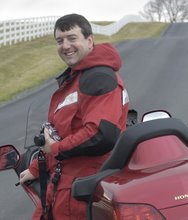Some people are attracted to motorcycling for the thrill of the ride, the speed, the lean. Hitting the apex. Others are drawn to motorcycling for the camradarie enjoyed by a group of riders, or, just the opposite--the solitude of the lone rider. Still others are intrigued and inspired by the machine and its innerworkings. Over the years, I've come to enjoy these aspects of riding, but the original draw for me was, and continues to be, something else.
How could you hope to enjoy the American Experience, how could you expect to discover the unique, vast, mythic, iconic Open Road on anything other than a motorcycle? You can't. Just as we have mythologized and romanticized the American West with the cowboy and his horse, we've done the same with our motorcycles and the people who ride them. You can only find The Road on A Bike. (You may recognize this concept -- it's the strategy Harley has pursued for the last twenty years. I still remember one of Harley's print ads from years back "Ride Hard or Stay Home.") Hey, I'm a believer.
Of course there are roads and then there are Roads, just as there are rides and Rides, bikes and Bikes. After years of riding, I realized I'd become all too familiar with "little r" roads. I'm talking about interstate highways, expressways, the roads we often succumb to following when time must be converted to distance most efficiently. The problem is, riding the interstate too often becomes a crutch, a habit. An excuse. "Oh, well, I've just got to get to Asheville in six hours, so I'll have to take the Interstate." An Interstate will get you between points most efficiently, but it's not a fulfilling experience. Sort of like going to Sunday School and skipping church.
In the last year couple of years, I've made a special point to plan trips following more Roads and fewer roads. On average, I can travel between points in the Appalachians on non-express US highways and state primary routes, tacking on no more than 25% to my travel time; the greatest portion of that time being added when I ride through small towns instead of around them. Once in a while, the time is even shorter.
I came to this change of mind a few years ago on a return trip from the Roanoke Valley region, following the superslab. The GPS had my arrival home pegged at about 4:30 in the afternoon. As my mind wandered from one thing to the next, I started asking myself what I'd do with the rest of the day. Really, what would an hour's difference in my return mean? Nothing. I formed a plan to dump the Interstate and jump on US 211, a much more interesting ride. How much time could that really add? With the GPS on board, I could easily find the answer.
I wheeled the bike off the slab at New Market, quickly realizing the first benefit of the new route: Pack's Frozen Custard stand. +1 for The Road. Heading east on US 211 I found myself largely alone and riding in clean air, a welcome contrast to dodging the wind blast of one truck after another. 211 is a far more scenic and entertaining route with a couple short sections of switchbacks crossing Massanutten and the Blue Ridge. Instead of riding mindlessly, I was fully engaged in the ride. In fact, for a half-hour since diverting, I hadn't paid much attention to the GPS, knowing it would be recalculating routes for a while until its intentions matched mine. So when I looked down and noted my newly estimated arrival time, I was a bit surprised. 4:50 p.m. A paltry twenty minutes was the total cost between slogging along the Interstate and enjoying a memorable ride along The Road.
Since then I've replaced most of my interstate journeys with alternate routes and it's had an interesting effect on my perspective in more than just the added travel time, extra curves, and better scenery. To travel the old US highways regularly and exclusively is to rediscover what it felt like to travel cross-country years ago. You don't just point your bike in a direction and ride for hundreds of miles without interruption. Riding on old roads requires thought and some navigational skill. The general store is no longer just a curiousity you pass by; it regains its status as an essential rest stop. Original and one-of-a-kind eateries replace the endless string of derivative pretenders like Applebees and Cracker Barrel.
There's an entirely different feel to travel when I sit in a restaurant surrounded by community members instead of a herd of fellow travelers, all in a similar rush to eat and get back on the road. Instead of detachment, I feel connected. My waitress expresses surprise when she asks where I've come from and where I'm headed. A local rider offers a few new route ideas, giving the impression that if asked he or she would gladly escort me. No one's in a hurry, so I tend to linger a bit longer and relax.
Before it meant getting to your destination as fast as possible, this is what travel used to be about, connecting with people outside your usual circle. Making discoveries along the way rather than counting miles. Stopping at a wayside for lunch instead of another value meal. Dropping a few coins at Dinosaurland or The Mystery Spot, not an in-room movie. Sticking around long enough for a slice of homemade pie with a fresh cuppa Joe. Stopping for the night in a town where everything's closed at 8:00 p.m. Kicking tires and trading stories at the filling station instead of paying at the pump.
This type of travel isn't faster, but it's far more satisfying. And, as I have come to realize, if you're not on The Road, you're not enjoying The Ride.



